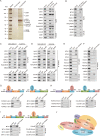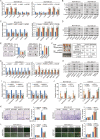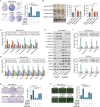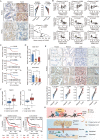RUNX2 recruits the NuRD(MTA1)/CRL4B complex to promote breast cancer progression and bone metastasis
- PMID: 35534547
- PMCID: PMC9613664
- DOI: 10.1038/s41418-022-01010-2
RUNX2 recruits the NuRD(MTA1)/CRL4B complex to promote breast cancer progression and bone metastasis
Abstract
Runt-related transcription factor 2 (RUNX2) is an osteogenesis-related transcription factor that has emerged as a prominent transcription repressing factor in carcinogenesis. However, the role of RUNX2 in breast cancer metastasis remains poorly understood. Here, we show that RUNX2 recruits the metastasis-associated 1 (MTA1)/NuRD and the Cullin 4B (CUL4B)-Ring E3 ligase (CRL4B) complex to form a transcriptional-repressive complex, which catalyzes the histone deacetylation and ubiquitylation. Genome-wide analysis of the RUNX2/NuRD(MTA1)/CRL4B complex targets identified a cohort of genes including peroxisome proliferator-activated receptor alpha (PPARα) and superoxide dismutase 2 (SOD2), which are critically involved in cell growth, epithelial-to-mesenchymal transition (EMT) and invasion. We demonstrate that the RUNX2/NuRD(MTA1)/CRL4B complex promotes the proliferation, invasion, tumorigenesis, bone metastasis, cancer stemness of breast cancer in vitro and in vivo. Strikingly, RUNX2 expression is upregulated in multiple human carcinomas, including breast cancer. Our study suggests that RUNX2 is a promising potential target for the future treatment strategies of breast cancer.
© 2022. The Author(s).
Conflict of interest statement
The authors declare no competing interests.
Figures







Similar articles
-
CUL4B Promotes Breast Carcinogenesis by Coordinating with Transcriptional Repressor Complexes in Response to Hypoxia Signaling Pathway.Adv Sci (Weinh). 2021 Mar 16;8(10):2001515. doi: 10.1002/advs.202001515. eCollection 2021 May. Adv Sci (Weinh). 2021. PMID: 34026424 Free PMC article.
-
SMYD3 associates with the NuRD (MTA1/2) complex to regulate transcription and promote proliferation and invasiveness in hepatocellular carcinoma cells.BMC Biol. 2022 Dec 27;20(1):294. doi: 10.1186/s12915-022-01499-6. BMC Biol. 2022. PMID: 36575438 Free PMC article.
-
[CRL4B complex promotes the development of pancreatic cancer by inhibiting secreted frizzled related protein 1].Zhonghua Zhong Liu Za Zhi. 2021 Jun 23;43(6):646-656. doi: 10.3760/cma.j.cn112152-20210108-00030. Zhonghua Zhong Liu Za Zhi. 2021. PMID: 34289556 Chinese.
-
The role of the MTA family and their encoded proteins in human cancers: molecular functions and clinical implications.Clin Exp Metastasis. 2009;26(3):215-27. doi: 10.1007/s10585-008-9233-8. Epub 2008 Dec 31. Clin Exp Metastasis. 2009. PMID: 19116762 Review.
-
Tumor metastasis-associated human MTA1 gene and its MTA1 protein product: role in epithelial cancer cell invasion, proliferation and nuclear regulation.Clin Exp Metastasis. 2003;20(1):19-24. doi: 10.1023/a:1022534217769. Clin Exp Metastasis. 2003. PMID: 12650603 Review.
Cited by
-
Serine Protease 27, a Prognostic Biomarker in Pan-cancer and Associated with the Aggressive Progression of Breast Cancer.Curr Med Chem. 2024;31(15):2073-2089. doi: 10.2174/0929867330666230324161329. Curr Med Chem. 2024. PMID: 37282654
-
Notoginsenoside R1 (NGR1) regulates the AGE-RAGE signaling pathway by inhibiting RUNX2 expression to accelerate ferroptosis in breast cancer cells.Aging (Albany NY). 2024 Jun 14;16(12):10446-10461. doi: 10.18632/aging.205940. Epub 2024 Jun 14. Aging (Albany NY). 2024. PMID: 38885076 Free PMC article.
-
RUNX2 mediated epithelial mesenchymal transition induced by TGF beta and Smad signaling promotes malignant progression in glioma.Sci Rep. 2025 Jul 23;15(1):26781. doi: 10.1038/s41598-025-09167-9. Sci Rep. 2025. PMID: 40702072 Free PMC article.
-
RUNX1-IT1 acts as a scaffold of STAT1 and NuRD complex to promote ROS-mediated NF-κB activation and ovarian cancer progression.Oncogene. 2024 Feb;43(6):420-433. doi: 10.1038/s41388-023-02910-4. Epub 2023 Dec 14. Oncogene. 2024. PMID: 38092960
-
The feedback loop between MTA1 and MTA3/TRIM21 modulates stemness of breast cancer in response to estrogen.Cell Death Dis. 2024 Aug 17;15(8):597. doi: 10.1038/s41419-024-06942-w. Cell Death Dis. 2024. PMID: 39154024 Free PMC article.
References
-
- Sung H, Ferlay J, Siegel RL, Laversanne M, Soerjomataram I, Jemal A, et al. Global cancer statistics 2020: GLOBOCAN estimates of incidence and mortality worldwide for 36 cancers in 185 countries. CA: a cancer journal for clinicians: (2021). - PubMed
Publication types
MeSH terms
Substances
LinkOut - more resources
Full Text Sources
Medical
Molecular Biology Databases
Miscellaneous

